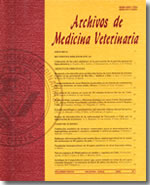Observation of tissular reaction of commercial polyamide seal used as a method of bond in renal and uterine pedicle in rabbits
Main Article Content
Abstract
Ligation is the most common localized and permanent method for the control of haemorrhages. It has been used for more than 4000 years through the employment of different materials, from linen, silk, sheep intestine or tendon fibers until the current use of synthetic materials, absorbables (polyglactine and polydioxanone) or non-absorbables (polypropilene, polyester and polyamide). Staples and vascular clips can also be employed for permanent haemostasia allowing a good occlusion of the vascular pedicles, but their high cost limits their use in veterinary surgery. In this study, tissular reaction at vascular pedicle level was evaluated in rabbits after using a polyamide seal. Six male rabbits underwent nephrectomy and the pedicle was ligatured with polyamide. The remaining six animals underwent ovariohysterectomy with the placement of a seal at uterine cervix level. The haemostasia provided by the implant was immediate and safe after its application. The macroscopic and microscopic observations of the animals showed that the tissular reaction was minimal. Neither tissular necrosis nor a severe inflammation degree were observed during histophatologic studies; nor signs of infection. The polyamide commercial seal is an easy to apply, safe technique, it also causes minimal tissular reaction and has a low cost, making possible its use in vascular pedicle ligatures at surgical veterinary practices.

